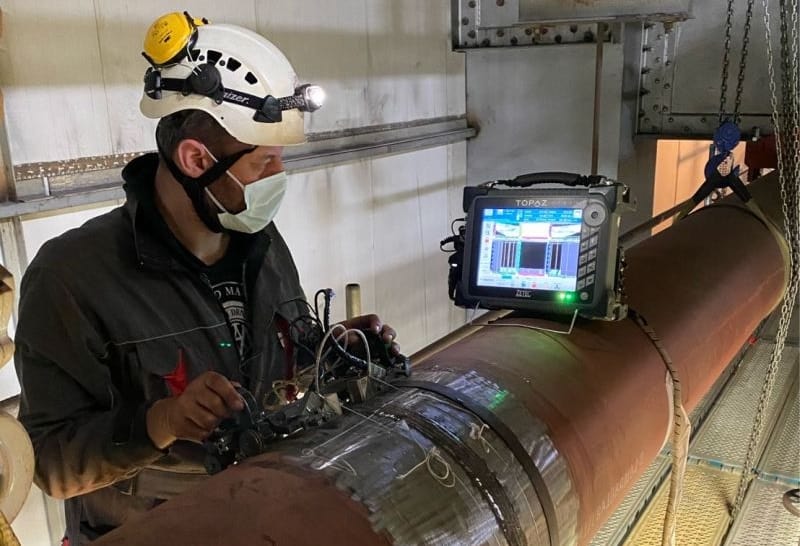Optimize Performance: Proactive Pipeline Welding Inspection Approaches
Optimize Performance: Proactive Pipeline Welding Inspection Approaches
Blog Article
Comprehensive Review of Pipe Welding Examination Treatments
In the realm of pipe building, making certain the stability and safety and security of bonded joints is vital. Pipeline welding evaluation procedures play a crucial role in ensuring that bonded links fulfill rigid market criteria and specifications. From thorough pre-welding evaluations to thorough post-weld analyses, a well-defined inspection process is necessary for keeping the structural soundness of pipelines. Comprehending the details of welding evaluation treatments is not just a regulative need but also an essential aspect of upholding the reliability of these important frameworks.
Pre-welding Examination Preparations
Before starting the welding process, thorough pre-welding evaluation preparations are essential to make certain the integrity and top quality of the weld joint. These prep work include a careful evaluation of the materials to be bonded, the welding equipment, and the job environment. First of all, the products should be evaluated for any defects, impurities, or incongruities that could endanger the weld. This consists of monitoring for appropriate material grades, measurements, and surface conditions. Pipeline Welding Inspection. In addition, the welding tools requires to be checked to validate that it remains in good working condition, adjusted properly, and suitable for the particular welding process. Any type of problems with the tools should be addressed immediately to stop defects in the weld. Finally, the workplace need to be evaluated for cleanliness, appropriate air flow, and precaution to guarantee a conducive setup for the welding operation. By performing comprehensive pre-welding evaluation preparations, prospective concerns can be recognized and fixed early, bring about reputable and top quality weld joints.
Welding Treatment Qualification
Thorough pre-welding inspection prep work lay the structure for the crucial process of Welding Procedure Credentials, making sure the integrity and high quality of the weld joint. Welding Procedure Qualification (WPQ) is an important step in the welding process that involves screening and licensing welding procedures to ensure they meet details standards and needs. The WPQ process typically consists of welding procedure specification advancement, welding treatment credentials screening, and paperwork of the results.
Throughout welding treatment specification advancement, crucial details such as the welding procedure, welding products, joint style, and welding criteria are defined to develop a comprehensive procedure. Ultimately, welding treatment qualification testing is carried out to confirm the proposed procedure's stability. This testing often entails welding examination coupons that are subjected to different mechanical and non-destructive examinations to examine the weld's quality and adherence to the specified standards.
In-process Weld Examination
Throughout the welding process, in-process weld evaluation plays an essential role in ensuring the quality and honesty of the weld joint - Pipeline Welding Inspection. This kind of evaluation involves monitoring the welding specifications, analyzing the weld grain development, and detecting any potential flaws or interruptions as they occur. By performing in-process weld assessments, welding drivers can promptly deal with any kind of concerns that might emerge, thus avoiding additional issues and making sure that the last weld fulfills the needed requirements
Typical techniques used for in-process weld evaluation include visual examination, fluid penetrant screening, magnetic particle testing, ultrasonic a fantastic read testing, and radiographic testing. Overall, in-process weld examination is essential for preserving the top quality and integrity of welded pipelines.
Non-destructive Testing (NDT)
Non-destructive Screening (NDT) is a crucial technique used in pipeline welding examination to evaluate the stability of weld joints without triggering damage to the bonded framework. By making use of different NDT techniques, examiners can evaluate the high quality of welds and determine any type of issues or discontinuities that may compromise the structural soundness of the pipeline. Typical NDT techniques utilized in pipeline welding evaluation consist of Radiographic Screening (RT), Ultrasonic Screening (UT), Magnetic Particle Checking (MPT), Fluid Penetrant Screening (LPT), and Visual Testing (VT)
RT includes the use of X-rays or gamma rays to generate pictures of the inner structure of the weld, allowing inspectors to detect issues such as porosity, cracks, or insufficient fusion. Additionally, VT includes aesthetic examination of welds to recognize any kind of noticeable imperfections.
Post-weld Assessment and Documentation


Paperwork of post-weld evaluation findings is vital for maintaining quality assurance documents and guaranteeing conformity with industry requirements and policies. Comprehensive reports need to include information regarding the evaluation methods made use of, the location and nature of any kind of problems discovered, and any kind of rehabilitative actions taken - Pipeline Welding Inspection. Correct paperwork not only offers as a document of the weld's high quality but additionally aids Find Out More in future upkeep and examination processes
Conclusion

In final thought, pipe welding assessment treatments play a vital role in guaranteeing the high quality and honesty of welds. Generally, adherence to correct examination procedures is essential to the success of pipeline welding tasks.
From thorough pre-welding examinations to comprehensive post-weld analyses, a well-defined assessment procedure is crucial for maintaining the structural strength of pipes. By performing in-process weld examinations, welding drivers can quickly attend to any problems that may emerge, thus stopping additional defects and making certain that the final weld fulfills the called for requirements.
Usual techniques utilized for in-process weld inspection include aesthetic assessment, fluid penetrant testing, magnetic bit YOURURL.com screening, ultrasonic screening, and radiographic testing.Non-destructive Screening (NDT) is a critical technique employed in pipeline welding inspection to evaluate the integrity of weld joints without triggering damage to the welded structure. Post-weld inspection entails numerous techniques to assess the welds for problems, including visual evaluation, dye penetrant testing, magnetic fragment screening, ultrasonic screening, and radiographic screening.
Report this page